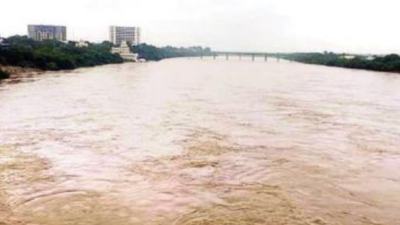- News
- City News
- aurangabad News
- Maharashtra: Marathwada gets 131% of normal rainfall, highest among 6 divisions
Trending
This story is from September 7, 2021
Maharashtra: Marathwada gets 131% of normal rainfall, highest among 6 divisions
With 716 mm rainfall since June, Marathwada has received 131% of its normal rainfall during the current rainy season, which is also the highest among the six divisions of Maharashtra in terms of expected showers received.

Godavari river flowing through Nanded city is filled to the brim
AURANGABAD: With 716 mm rainfall since June, Marathwada has received 131% of its normal rainfall during the current rainy season, which is also the highest among the six divisions of Maharashtra in terms of expected showers received.
Konkan division is second on the list with 114% normal showers followed by Amravati (105%), Pune (89%), Nagpur (88%), and Nashik (78%). As per official data, the state as a whole has received an average of 917mm rainfall till Monday morning, which is 107% of the normal rainfall from June onwards.
Shriniwas Aundhkar, director of APJ Abdul Kalam Astro Space and Science Centre in Aurangabad, said timely arrival of monsoon coupled with favourable weather conditions over Bay of Bengal have resulted in surplus rainfall for Marathwada.
“The favourable weather system during the onset of monsoon over Arabian sea saw Marathwada getting expected showers. While a considerably long dry spell was observed in August across many parts of the region, low pressure area over Bay of Bengal during the recent past again revived the monsoon conditions, largely benefiting the eastern parts of Marathwada,” he said.
Among eight districts of Marathwada, Beed has registered the highest 161% of normal rainfall (692 mm) since June 1, followed by Jalna (159%, 779 mm), Aurangabad (132%, 607 mm), Latur (118% 660 mm), Osmanabad (129%, 588 mm), Nanded (124%, 841 mm), Parbhani (122%, 765 mm) and Hingoli (114%, 768 mm).
Konkan division is second on the list with 114% normal showers followed by Amravati (105%), Pune (89%), Nagpur (88%), and Nashik (78%). As per official data, the state as a whole has received an average of 917mm rainfall till Monday morning, which is 107% of the normal rainfall from June onwards.
Shriniwas Aundhkar, director of APJ Abdul Kalam Astro Space and Science Centre in Aurangabad, said timely arrival of monsoon coupled with favourable weather conditions over Bay of Bengal have resulted in surplus rainfall for Marathwada.
“The favourable weather system during the onset of monsoon over Arabian sea saw Marathwada getting expected showers. While a considerably long dry spell was observed in August across many parts of the region, low pressure area over Bay of Bengal during the recent past again revived the monsoon conditions, largely benefiting the eastern parts of Marathwada,” he said.
Aundhkar said the entire region, including western parts of Marathwada along with Nashik and Ahmednagar that fall in upstream areas of Jayakwadi dam from Aurangabad district, were expected to get adequate showers in near future due to the possibility of favourable conditions of monsoon over the Western Ghat section.
Among eight districts of Marathwada, Beed has registered the highest 161% of normal rainfall (692 mm) since June 1, followed by Jalna (159%, 779 mm), Aurangabad (132%, 607 mm), Latur (118% 660 mm), Osmanabad (129%, 588 mm), Nanded (124%, 841 mm), Parbhani (122%, 765 mm) and Hingoli (114%, 768 mm).
End of Article
FOLLOW US ON SOCIAL MEDIA










